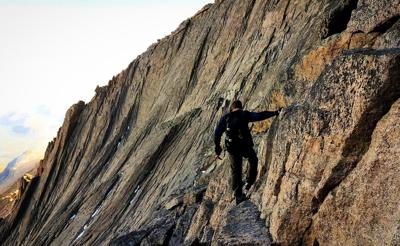Often billed as the Colorado fourteener with the highest failure rate, Longs Peak towers over the northern Front Range, acting as a constant reminder of the adventure that awaits the city dwellers below. Here are a few things you should be aware of before you attempt to summit the only fourteener in Rocky Mountain National Park.
1. Longs Peak is exposed.
While the first portion of the standard route up Longs is relatively tame, this leg is in stark contrast with the portion found past the Keyhole – an iconic notch in the ridge-line that must be passed. After passing through the Keyhole, one mistake could mean death, with one source citing 9 deaths on this mountain between 2010 and 2017. The most infamous section is known as the Narrows, an uneven path no more than two-feet wide at parts, flanked by a drop of several hundred feet.

Here’s a shot of me taken by my partner on the Narrows section of the climb. As you can see, the path gets pretty narrow, and there’s a big drop.
That’s not the only dangerous section, either. There’s also the “Homestretch,” which consists of climbing up a steep slab of rock with limited holds, and “the Trough,” which is a steep climb through a loose rock field that becomes especially dangerous on crowded days due to risks associated with falling rocks. On another note: make sure you’re wearing sunscreen. There’s no tree coverage for a majority of the climb.

A look at the steepness of the Homestretch section, the last part of the climb to the summit. Photo Credit: Spencer McKee.
2. Longs Peak is difficult.
While Longs Peak is part of Rocky Mountain National Park, climbing it is no attraction for the visiting tourist. One of the reasons that the failure rate on this peak is so high is the fact that many people embark on the journey when they have no business climbing a 14,255-foot mountain in the first place. The total elevation of the standard route is a whooping 5,100 feet over 14.5 round trip miles, almost all of which is gained during the trip to the summit – so, half of that distance. That means you’re gaining around 700 feet per mile…it adds up. Note: due to the amount of scrambling on this climb, you won’t have a traditional trail for a large chunk of the route. Instead, you’ll follow Colorado “C” icons that have been painted on the rock.

Colorado “C” trail markers lead the way to the summit of Longs. Photo Credit: Spencer McKee.
3. Longs Peak is known for unpredictable weather.
The route up Longs Peak is unique in that it wraps around the mountain before reaching the summit. This makes it extremely difficult to reliably predict the weather that will be encountered during the final, most difficult portion of the climb. It simply can’t be seen until the aforementioned “Keyhole” is reached, after which one is able to peer across a large mountain bowl frequently filled with dangerous storm clouds. This “Keyhole” portion is also where the slow scrambling starts, meaning there’s an increased level of commitment to the climb that makes analyzing the weather crucial. From this point on, if something goes wrong, it’s a long and slow trek back to safety. Also worth noting is that wind is especially strong on this peak. At times, its frigid blast can hit you hard enough to send you off the side of the mountain, capable of forming hazardous ice on rocks on otherwise sunny days.

The Keyhole notch in the ridge. Note the small stone shelter on it’s left. Photo Credit: Spencer McKee.
4. You’ll have to get started early.
Due to the length and difficulty of the route, you’ll want to get started very early to avoid the frequent afternoon storms that hit many of Colorado’s high-altitude areas during the warmer months of the year. Aim for a start time between 2 and 3 AM, seeking to hit the boulder field beneath the Keyhole around sunrise.

The tail-end of a sunrise hits the boulder field on the way to the Keyhole. Photo Credit: Spencer McKee.
5. Your knees will hate you.
Because Longs is a long, steep hike, expect it to take its toll on your knees. During my trek to the top, I found the downhill portion post-summit was the most taxing. Awkward steps during the return trip down the scrambling section will have your knees aching. The long walk back to the trailhead doesn’t help.
6. Bring extra resources.
Due to the length of Longs Peak and the difficultly it’s terrain poses for rescue measures, bring additional food and water with you on your climb, along with extra layers and basic survival tools. You’ll spend a large portion of the trek under a draining sun and the physically taxing nature of the scrambling section is sure to drain your body’s reserves.













(0) comments
Welcome to the discussion.
Log In
Keep it Clean. Please avoid obscene, vulgar, lewd, racist or sexually-oriented language.
PLEASE TURN OFF YOUR CAPS LOCK.
Don't Threaten. Threats of harming another person will not be tolerated.
Be Truthful. Don't knowingly lie about anyone or anything.
Be Nice. No racism, sexism or any sort of -ism that is degrading to another person.
Be Proactive. Use the 'Report' link on each comment to let us know of abusive posts.
Share with Us. We'd love to hear eyewitness accounts, the history behind an article.